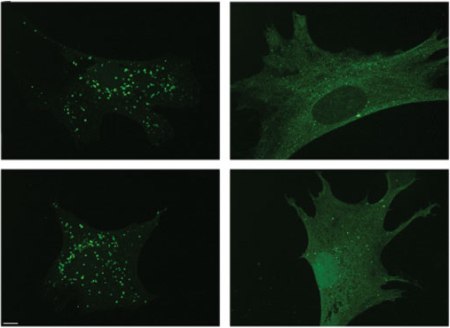Dec 24 2012
In the perilous hours immediately after birth, a newborn mammal must survive the sudden loss of food supply from its mother. Under normal circumstances, newborns mount a metabolic response to ward off starvation until feeding occurs. This survival response involves a process of controlled breakdown of internal energetic sources known as autophagy. Although autophagy has been well documented, the key mechanistic regulators of autophagy in vivo have remained poorly understood.
 To determine if the enzyme RagA plays a role in triggering autophagy, a protein involved in autophagy has been tagged green in these embryonic mouse skin cells. (Courtesy of Nature)
To determine if the enzyme RagA plays a role in triggering autophagy, a protein involved in autophagy has been tagged green in these embryonic mouse skin cells. (Courtesy of Nature)
Whitehead Institute researchers have discovered that a family of nutrient-sensing enzymes, dubbed Rag GTPases, modulates the activity of the mTORC1 protein complex, whose inhibition is essential for autophagy and survival in newborns. The finding, reported this week in the journal Nature, emerges from the lab of Whitehead Member David Sabatini, whose earlier in vitro studies showed that mTORC1 (for "mechanistic target of rapamycin complex 1") senses the presence of vital amino acids via interactions with Rag GTPases.
To assess the impact of this Rag GTPase-mTORC1 relationship in mammals, the lab generated mice genetically altered to continually express an active form of the GTPase RagA and compared them with wild-type mice. In normal mice, RagA is activated in the presence of nutrients, and turns on the mTORC1 pathway, which regulates organismal growth in response to nutrient availability. If the mice are deprived of nutrients, RagA is switched off, deactivating mTORC1 and initiating autophagy to tide the animal over until the next feeding. However, in the altered mice, RagA's continuous activity keeps mTORC1 active, despite a dearth of available nutrients. Instead of mTORC1 triggering autophagy, the animals' metabolisms remain unchanged, resulting in nutritional crisis and death.
"What happens to a newborn animal with the RagA enzyme always on is pretty shocking," says Sabatini, who is also a professor of biology at MIT and a Howard Hughes Medical Institute (HHMI) investigator. "A normal neonate animal within an hour after birth responds to that condition, but one with its RagA stuck 'on' doesn't, and it dies. It basically has a huge energetic and nutritional crisis because it can't make the adaption."
These striking results stunned Alejo Efeyan, a postdoctoral researcher in the Sabatini lab, and first author of the Nature that describes this work.
"We were surprised that there was no inhibition of this pathway independent of RagA—that there is no backup system," says Efeyan. "And that RagA is a more global nutrient sensor that goes beyond its known function as an amino acid sensor."
RagA's role as an amino acid sensor had been established in cultured cells by the Sabatini lab. Yet when Efeyan compared nutrient levels in fasting newborn RagA-active mice with those of fasting pups with normal RagA, not only amino acids were reduced in RagA-active animals, also glucose levels were dangerously low. The animals were unable to "sense" either of these reductions, so autophagy failed to initiate in the RagA-active pups, which all died within hours of birth.
This newly identified function for RagA suggests much remains unknown about the cell biology of nutrient sensing, an area of research that Sabatini and his lab continue to investigate.